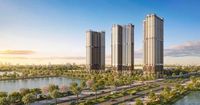The trend of real estate investors moving south is expected to boom in 2025, according to Vu Cuong Quyet, CEO of Dat Xanh Mien Bac. As the northern real estate market, particularly in Hanoi, shows signs of saturation, investors are increasingly looking for opportunities in the southern provinces.
In recent years, the northern real estate market has experienced a period of hot growth, with property prices continuously reaching new heights. However, recent reports indicate that this growth may be slowing. According to a new report from CBRE, the average apartment price in Hanoi for the first quarter of 2025 has reached approximately 75 million VND per square meter, reflecting a 3% increase from the previous quarter. This marks the lowest quarterly price increase since the second quarter of 2023.
As the potential for price growth diminishes and liquidity begins to stagnate, many investors holding apartments in Hanoi are opting to sell at peak prices and restructure their investments. This shift is prompting a significant number of investors in rental apartments to sell their properties and redirect their funds toward assets with better appreciation potential.
Vu Cuong Quyet emphasizes that now is the time to restructure investment portfolios, with investors seeking assets that promise higher growth rates. He notes that real estate in the south is entering a strong recovery cycle, driven by improved transportation infrastructure and rapid urbanization. Provinces like Binh Duong, Long An, Dong Nai, and Can Tho still offer substantial profit opportunities.
"Apartments in industrial urban areas such as Binh Duong and Can Tho are becoming bright spots due to real housing demand and high rental potential, with prices only about one-third of those in Hanoi or Ho Chi Minh City," Quyet stated. He highlights projects like Benhill in Thuan An and Cara River Park in Can Tho as suitable for small to medium investors, thanks to flexible payment policies from developers.
When it comes to land plots, Quyet expresses particular enthusiasm for areas near Ho Chi Minh City, such as Long An and Dong Nai, where transportation projects like the Ben Luc – Long Thanh Expressway and Ring Road 3 are set to drive price increases. "Land plots priced below 20 million VND per square meter in well-connected locations are rare opportunities," he asserted.
However, Quyet also cautions investors to be wary of legal issues and to selectively choose projects with genuine potential, avoiding the pitfalls of speculative bubbles driven by unreliable brokers. Data from Batdongsan.com.vn shows that interest from northern investors in southern real estate has surged by 7% in the fourth quarter of 2024, reflecting a clear trend of capital migration.
Factors such as completed infrastructure, lower prices compared to the north, and local demand are creating an irresistible allure for the southern region. On March 16, 2025, a seminar titled 'Show day 1: Southward investment in real estate cash flow' was held in Hanoi, attracting hundreds of interested investors. At the event, many investors finalized purchases of apartments and land in Binh Duong, Long An, and Can Tho.
Looking ahead, on April 16, 2025, a series of southern projects will be introduced to northern investors at the Grand Plaza Hotel. These include the Bcons Uni Valley project in Binh Duong and the Izumi Urban Area in Dong Nai, along with other developments like Waterpoint and River Gateway in Long An.
According to the Vietnam Real Estate Brokers Association (VARS), the market is poised to enter a new growth cycle in 2025, driven by foundational elements such as a complete legal framework, maintained low-interest rates, and robust infrastructure investment. The southern region is being strongly promoted for regional connectivity, with key transportation projects totaling over 231 trillion VND, including Metro Line 1, the Ben Luc – Long Thanh Expressway, and Long Thanh Airport.
These developments are expected to significantly enhance the value of satellite urban areas and open up new growth spaces for the real estate market surrounding Ho Chi Minh City. Thus, markets with strong economic development potential, well-planned infrastructure, and legally sound projects are set to become attractive investment destinations for northern customers and investors nationwide.
In a related trend, as property prices in Hanoi's inner city continue to rise, there is a growing demand for real estate in suburban areas. According to Hanoi's Capital Planning, by 2030, the permanent population is projected to reach approximately 11 million, up from the current 9 million, along with a floating population of 1.5 million. The urbanization rate is expected to hit 70% by 2030, up from 49% today.
Despite improvements in housing supply, it has yet to meet the market's substantial demand. The disparity between supply and demand has led to continuously rising prices in Hanoi's inner city. In the fourth quarter of 2024, Savills reported that average secondary prices in inner-city districts ranged from 190 to 450 million VND per square meter for villas and adjacent houses, while high-rise apartments averaged between 65 and over 300 million VND per square meter.
As housing prices in the inner city remain high and access to affordable housing becomes increasingly limited, there is a notable trend of expanding demand for housing in suburban areas. This shift is exacerbated by the diminishing land availability in the inner city, even in areas adjacent to Ring Roads 2 and 3.
The larger goal set out in the Hanoi Capital General Planning until 2045, with a vision extending to 2065, is to build a modern, smart, green, and sustainable city. To achieve this, Hanoi is adjusting its urban development direction, prominently featuring a policy of decentralizing the population out of the inner city to alleviate infrastructure pressure and redistribute population density.
Areas such as the Old Quarter and Ho Guom will be encouraged to relocate residents to develop these spaces into tourism, commerce, and cultural hubs. Meanwhile, the central city will expand westward and southward, linking with the Ring Road 4 urban corridor.
Hanoi is making significant investments in transportation, technical, and social infrastructure systems in suburban cities. Key development areas include the West and South, East, and North of the Red River, all planned according to specific functions and developed through the Transit-Oriented Development (TOD) model.
Major projects like Vinhomes Ocean Park in Gia Lam have already seen high demand in the fourth quarter of 2024, with sales rates exceeding 50%. Suburban areas such as Dong Anh, Me Linh, and Thuong Tin are also experiencing significant demand, with Dong Anh leading primary transactions at 84%.
While the potential for suburban development is promising, challenges remain. The timeline for large projects can extend for years, and substantial investment costs may pressure budgets and inflate land prices. Buyers are advised to carefully consider factors such as infrastructure progress, the capability and reputation of developers, and project legal transparency to mitigate risks associated with new housing projects linked to infrastructure development.





